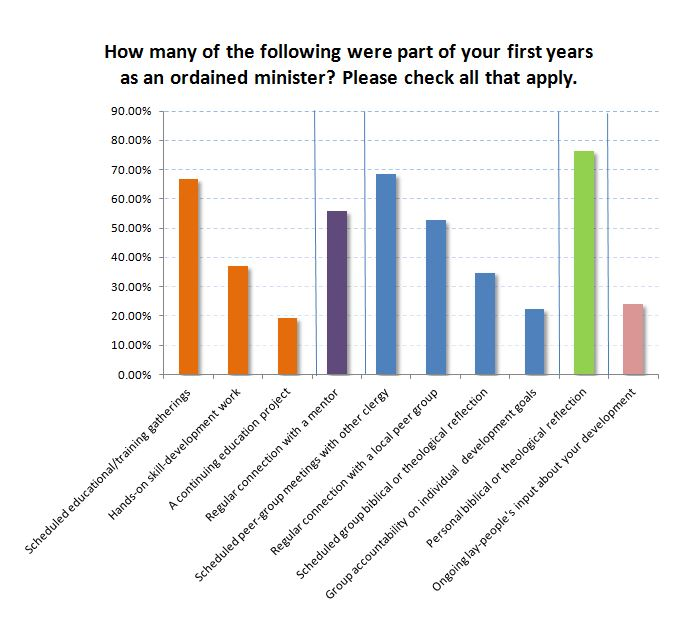Continuing support and development opportunities help pastors and priests combat the challenges of isolation, burnout, dissatisfaction, and what might be called “death by mindless routine.” As in any profession, these opportunities help pastors and priests continue to grow, gain new perspectives, and develop strong professional and personal networks with others in the same work.
The impact of such support and development opportunities depends on how strongly clergy pursue and invest themselves in these chances for enrichment and growth. Just over 90% of pastors and priests reported taking part in continuing education opportunities at least once a year—and nearly 10% reported they did not. But one-fourth (24.6%) of these clergy also indicated that continuing education offerings are neither convenient nor worthwhile—half of those who do not participate regularly, and 21.5% of those who do participate regularly.
This suggests that at least 1 in 5 clergy in a continuing education program is unhappy about being there. Anyone who has participated in continuing education has seen those folks—they tend to find each other, cluster in a small group in the back of the room, and smirk, grimace, and grumble their way through the session. Sure, their frustration may be with the specific presenter or program, but people shape their own experiences through how they choose to engage those experiences.
There are many other pathways for ongoing support and learning the art of Christian ministry and leadership, beyond continuing education programs. Pastors and priests can find support and development opportunities by doing any of the following:
- consulting with mentors
- forming or joining peer groups that provide support and focused mutual learning
- engaging in personal study, retreats, or spiritual direction or therapy
- intentionally seeking to learn from laypeople
- completing advanced degrees or certificate programs
Furthermore, there are differing degrees of intentionality and focus in learning in these different settings and situations. For instance, clergy can attend continuing education conferences but engage minimally. Conferences and workshops selected by clergy can provide general overviews or big ideas, or provide focused training and skill-development in particular types of ministry and leadership. Likewise, clergy gatherings and small groups can have varying degrees of focus, accountability, and intention.
This chart shows results of a checklist of types and levels of engagement in ongoing support and development during the first few years after seminary and ordination. This chart reveals the varied pathways and different levels of investment by new pastors and priests in their continuing development.
Over three-fourths of pastors and priests indicated that they engaged in personal biblical or theological reflection. Over two-thirds also affirmed attending both scheduled educational or training gatherings and scheduled clergy peer-group meetings. Only a little more than half of pastors and priests claimed regular ongoing contact with their mentors (if they had one during this time period). And only one-fourth indicated they had ongoing input from laypeople about their development.
But how intentional or invested are clergy in each of these areas of continuing development? Consider, on the chart, the degree of focus and intention in continuing education and peer-group gatherings. While two-thirds of clergy affirmed their involvement in scheduled continuing education programs, only 37% reported intentionally focusing on skill development, and only 19% reported doing a continuing education project that required more sustained attention and effort over time.
Likewise, while two-thirds of clergy attended scheduled group gatherings of pastors or priests, only a little over half indicated regularly connecting with other clergy locally in their own areas of ministry, only 32% reported participating in groups regularly focused on theological or biblical study, and only 22% reported any group commitment to accountability regarding individuals’ goals for continuing development.
For Your Consideration
- What does this tell us about clergy isolation?
- If intentionality and investment in continuing growth is a signal of clergy wellness and leadership effectiveness, how can we help clergy increase their participation and focused effort?
Related Article



